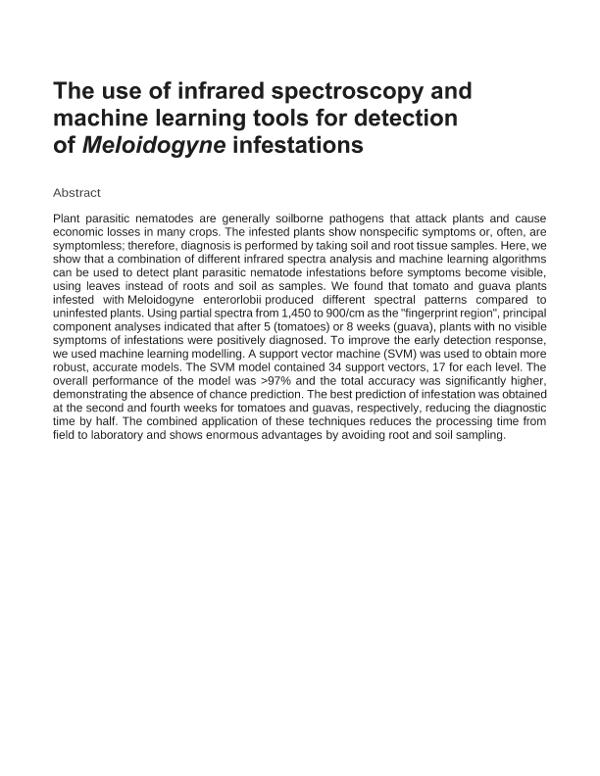Mostrar el registro sencillo del ítem
The use of infrared spectroscopy and machine learning tools for detection of Meloidogyne infestations
| dc.contributor.author | San‐Blas, Ernesto | |
| dc.contributor.author | Paba, Gabriel | |
| dc.contributor.author | Cubillán, Néstor | |
| dc.contributor.author | Portillo, Edgar | |
| dc.contributor.author | Casassa-Padrón, Ana M. | |
| dc.contributor.author | González‐González, César | |
| dc.contributor.author | Guerra, Mayamarú | |
| dc.date.accessioned | 2020-11-05T20:59:51Z | |
| dc.date.available | 2020-11-05T20:59:51Z | |
| dc.date.issued | 2020-08-01 | |
| dc.date.submitted | 2020-10-30 | |
| dc.identifier.citation | San‐Blas, E., Paba, G., Cubillán, N., Portillo, E., Casassa‐Padrón, A. M., González‐González, C., & Guerra, M. (2020). The use of infrared spectroscopy and machine learning tools for detection of Meloidogyne infestations. Plant Pathology, 69(8), 1589-1600. https://doi.org/10.1111/ppa.13246 | spa |
| dc.identifier.uri | https://hdl.handle.net/20.500.12585/9555 | |
| dc.description.abstract | Plant parasitic nematodes are generally soilborne pathogens that attack plants and cause economic losses in many crops. The infested plants show nonspecific symptoms or, often, are symptomless; therefore, diagnosis is performed by taking soil and root tissue samples. Here, we show that a combination of different infrared spectra analysis and machine learning algorithms can be used to detect plant parasitic nematode infestations before symptoms become visible, using leaves instead of roots and soil as samples. We found that tomato and guava plants infested with Meloidogyne enterorlobii produced different spectral patterns compared to uninfested plants. Using partial spectra from 1,450 to 900/cm as the "fingerprint region", principal component analyses indicated that after 5 (tomatoes) or 8 weeks (guava), plants with no visible symptoms of infestations were positively diagnosed. To improve the early detection response, we used machine learning modelling. A support vector machine (SVM) was used to obtain more robust, accurate models. The SVM model contained 34 support vectors, 17 for each level. The overall performance of the model was >97% and the total accuracy was significantly higher, demonstrating the absence of chance prediction. The best prediction of infestation was obtained at the second and fourth weeks for tomatoes and guavas, respectively, reducing the diagnostic time by half. The combined application of these techniques reduces the processing time from field to laboratory and shows enormous advantages by avoiding root and soil sampling. | spa |
| dc.format.mimetype | application/pdf | spa |
| dc.language.iso | eng | spa |
| dc.source | Plant Pathology Volume 69, Issue 8 | spa |
| dc.title | The use of infrared spectroscopy and machine learning tools for detection of Meloidogyne infestations | spa |
| datacite.rights | http://purl.org/coar/access_right/c_14cb | spa |
| oaire.version | http://purl.org/coar/version/c_970fb48d4fbd8a85 | spa |
| dc.identifier.url | https://bsppjournals.onlinelibrary.wiley.com/doi/epdf/10.1111/ppa.13246 | |
| dc.type.driver | info:eu-repo/semantics/article | spa |
| dc.type.hasversion | info:eu-repo/semantics/publishedVersion | spa |
| dc.identifier.doi | 10.1111/ppa.13246 | |
| dc.subject.keywords | Artificial intelligence | spa |
| dc.subject.keywords | Fourier transformed infrared spectroscopy – attenuated total reflectance (FTIR‐ATR) | spa |
| dc.subject.keywords | Genetic algorithms | spa |
| dc.subject.keywords | Genetic algorithms | spa |
| dc.subject.keywords | Meloidogyne enterolobii | spa |
| dc.subject.keywords | Plant parasitic nematodes | spa |
| dc.subject.keywords | Support vector machine | spa |
| dc.rights.accessrights | info:eu-repo/semantics/closedAccess | spa |
| dc.identifier.instname | Universidad Tecnológica de Bolívar | spa |
| dc.identifier.reponame | Repositorio Universidad Tecnológica de Bolívar | spa |
| dc.publisher.place | Cartagena de Indias | spa |
| dc.type.spa | http://purl.org/coar/resource_type/c_6501 | spa |
| dc.audience | Investigadores | spa |
| oaire.resourcetype | http://purl.org/coar/resource_type/c_2df8fbb1 | spa |
Ficheros en el ítem
Este ítem aparece en la(s) siguiente(s) colección(ones)
-
Productos de investigación [1453]
Universidad Tecnológica de Bolívar - 2017 Institución de Educación Superior sujeta a inspección y vigilancia por el Ministerio de Educación Nacional. Resolución No 961 del 26 de octubre de 1970 a través de la cual la Gobernación de Bolívar otorga la Personería Jurídica a la Universidad Tecnológica de Bolívar.












